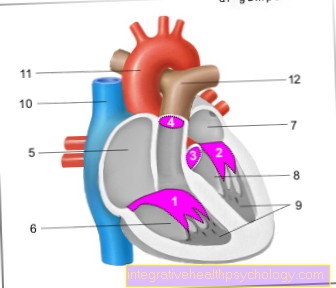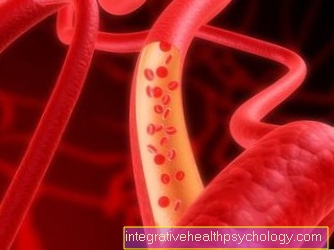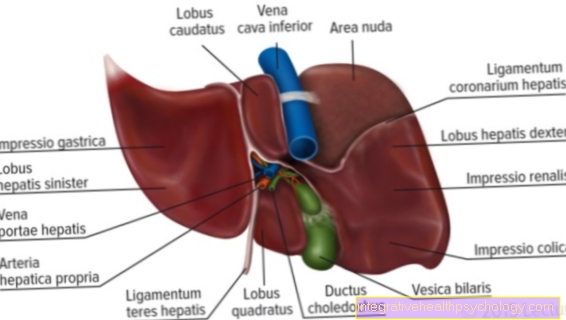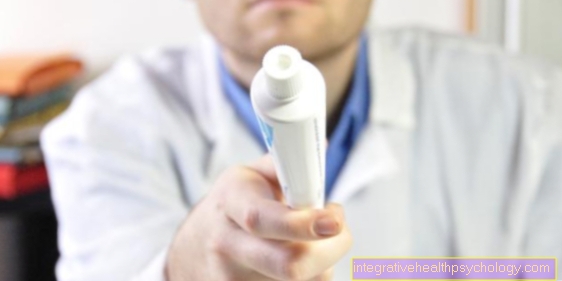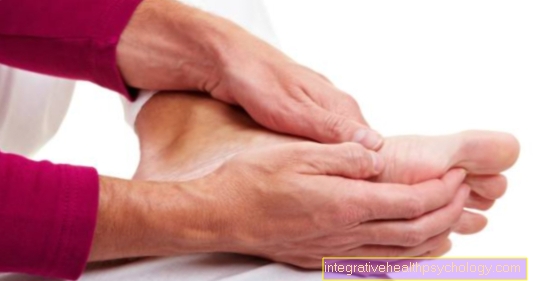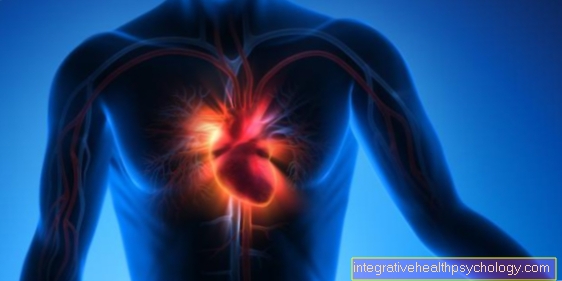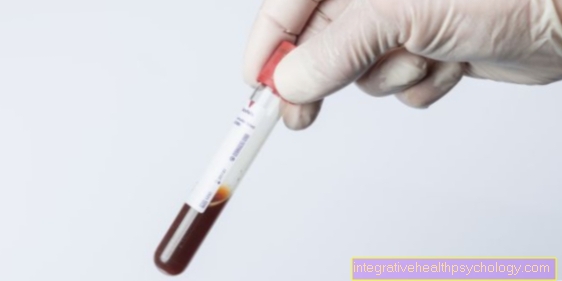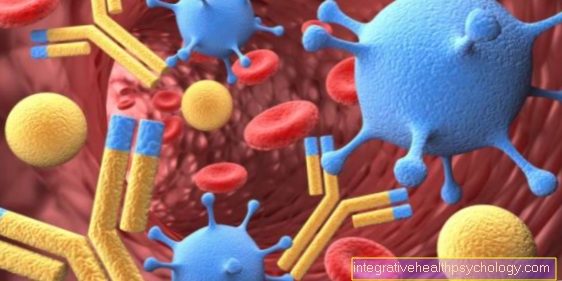Symptoms of Sarcoid
introduction
Sarcoid granulomas can in principle form in any human organ. The possible symptoms that affected patients show show great variability.
The variety of symptoms mainly affects the chronic form of sarcoid.
The lungs and hilum lymph nodes are most commonly affected, but the liver, spleen, skin, other lymph nodes, muscles, eyes, heart muscle tissue, the central nervous system, bones, and lacrimal and salivary glands can also be affected.
It sometimes happens that the sarcoid is discovered by chance in a symptom-free stage in the course of a chest X-ray based on the swelling of the lung lymph nodes.
Read more on the topic: Chest x-ray (chest x-ray)

Symptoms of sarcoid
In 20% of the cases of sarcoid, symptoms of obstruction of nasal breathing, i.e. an infestation of the upper respiratory tract, occur. Affected lymph nodes are enlarged, have a firm, rubbery consistency, can be moved easily and are not painful.
Around every fourth sarcoid patient also suffers from changes in the eyes; what is known as uveitis, i.e. inflammation of the uvea, the middle skin of the eye, is in the foreground.
The liver and spleen can be enlarged; if the heart is affected, cardiac arrhythmias can occur.
The central nervous system can also be affected by granuloma formation, which can lead to a wide variety of symptoms, e.g. Visual and hearing impairment, depending on the exact location of the granuloma.
All of these symptoms can occur in a sarcoid disease, but the composition and ultimate expression of the individual symptom complexes usually varies considerably.
Fever and fatigue with sarcoid
General symptoms often occur, especially in the acute form of sarcoid.
This includes a reduction in performance, tiredness and a feeling of exhaustion. A fever of over 38 ° C also often occurs. Likewise, about half of all those affected experience joint pain, nausea and digestive disorders.
Every now and then there is also weight loss, as the body is very strained and consumes a lot of energy.
Lymph node swelling in sarcoid
The lymph nodes play a major role in sarcoid disease, as in most cases they are also affected and enlarge. The swelling of the lymph nodes is often the first sign of sarcoid. It is usually painless.
The enlargement is often localized in the groin or in the armpit and can sometimes be felt by yourself. The lymph nodes in the lungs are also usually enlarged, which can be seen in the x-ray of the lungs when diagnosing sarcoid.
The following topic could also be of interest to you: Lymph node swelling - How dangerous is it?
Typical symptoms of chronic sarcoid
In contrast to acute sarcoid, chronic sarcoid has a gradual course. This means that the disease goes unnoticed for a long time, as the symptoms are barely or nonexistent for a long time. In chronic sarcoid, all organs can be affected, which is why the symptoms can be very different.
The lungs are affected in approx. 90% of cases, which, in contrast to the acute form, hardly manifests itself in chronic sarcoid. Occasionally, dry coughs and shortness of breath can occur during exercise. The lymph nodes are almost always affected, which is usually expressed in a painless swelling in the groin or armpit area.
The eyes and skin are also more commonly affected in chronic sarcoid. This often manifests itself in eye inflammation with visual disturbances, pain and redness of the eye, as well as various skin rashes, especially on the lower legs or in the area of the face. But all other organs, such as the liver, kidneys, nervous system or heart can also be affected, which causes different symptoms depending on the infestation. The latter can lead to cardiac arrhythmias, for example.
Our next topic could also be of interest to you: Inflammation of the eye - how dangerous is it?
Symptoms on the lungs
The organ most commonly affected in both acute and chronic sarcoid is the lungs.
In the acute form, in particular, there is a pronounced irritable cough that is often dry. Breathlessness also often occurs under exertion, which can be very limiting for those affected. There is also pain in the chest area. Many also describe a feeling of pressure with an uncomfortable load in the chest. In addition, there is the swelling of the lymph nodes in the area of the lung root, which can typically be seen in an X-ray of the lungs.
With chronic sarcoid, however, the lung involvement is often rather symptom-free. This increases the risk that sarcoid will be diagnosed late, which occasionally even happens by chance. If symptoms occur in the chronic form, these are primarily a dry cough and the occurrence of shortness of breath during physical exertion.
Symptoms on the skin
The skin also often shows symptoms in sarcoid disease, which can manifest themselves in various forms.
In chronic sarcoid, the skin is affected in 20-50% of cases. Often the first skin manifestations appear before other organs are affected and can therefore be used as the first sign of suspicion. One possible manifestation is the so-called erythema nodosum, i.e. a nodular reddening of the fatty tissue under the skin. This often occurs on the lower legs and is very painful when pressed.
Another form is lupus pernio, which affects the skin around the nose and cheeks. Here, reddish skin coverings with small nodules form, which, for example, make the nose look bulbous. Older scars can also be affected by sarcoid, which changes the color to bluish and inflames the scar tissue.
In the so-called Löfgren syndrome, a combination of three typical symptoms, erythema nodosum also occurs on the lower legs.
Are you more interested in this topic? You can read more detailed information in our next article: Sarcoid of the skin - causes, symptoms and therapy
Symptoms on the joints
Sarcoid can also cause symptoms in the joints. All components of the joint, i.e. both the bone ends and the synovial fluid or the tendons that extend over them, can be inflamed.
Regardless of which structure is affected, pain always occurs. These become stronger when the joint is moved. The pain is most severe when the joint is subjected to heavy loads, such as in the right knee joint while jumping on the right leg. As sarcoid progresses, the surrounding soft tissues are often affected, which increasingly restricts the mobility of the joint.
Acute sarcoid can cause so-called polyarthritis, which means that several different joints are inflamed. Polyarthritis also occurs in Löfgren's syndrome, and the ankle joints are particularly affected. But chronic sarcoid also often affects the joints.
Symptoms around the eyes
The eyes are affected in 25-60% of all cases with sarcoid. Any structure of the eye can be affected. Both sides are often affected, so both eyes are usually affected. Since the eye involvement often goes unnoticed, an ophthalmological examination should always take place when diagnosing sarcoid.
The most common manifestation of sarcoid in the eyes is so-called uveitis, i.e. the inflammation of the middle skin of the eye. In the case of anterior uveitis, pain and reddening of the affected eye often occur. Furthermore, those affected often react more sensitively to light. The posterior uveitis tends to have few symptoms.
But the iris, i.e. the iris, can also be affected by sarcoid. This also leads to pain and increased sensitivity to light. If the involvement of the eyes goes unnoticed, the optic nerve can also be impaired with permanent visual disturbances, which is why it is very important to see an ophthalmologist at an early stage.
Heart symptoms
In the chronic form, sarcoidosis can also affect the heart, although this often remains without symptoms. However, if symptoms occur, these can be very diverse. If sarcoid inflammatory tissue forms on the nerves of the heart, cardiac arrhythmias can occur, which can vary in severity.
Pericardial effusion, i.e. an accumulation of fluid in the pericardium, can also occur, which can lead to shortness of breath, especially under stress.
Are you more interested in this topic? Read our next article below: Cardiac arrhythmias
Symptoms of the kidney
The main symptoms of sarcoid disease of the kidneys are increased excretion of calcium. This is also known as hypercalciuria. Since the kidneys are not geared to secrete as much calcium and thereby mess up the electrolyte balance, this can have serious consequences.
With advanced sarcoid disease, kidney failure can even occur and the kidney is no longer able to perform its function. This can, for example, lead to an increased accumulation of water in the body.
Symptoms of typical sarcoid Löfgren syndrome
Löfgren's syndrome is a form of acute sarcoid that is associated with a typical combination of symptoms and occurs mainly in women. It is a very acute disease that needs to be treated quickly.
The classic so-called triad of symptoms include erythema nodosum, arthritis and bihilial lymphadenopathy. Erythema nodosum is a certain type of rash with a nodular reddening of the fatty tissue under the skin. It occurs mainly on the lower legs and is very painful for those affected when pressed.
Arthritis, i.e. the inflammation of the joints, occurs in Löfgren's syndrome mainly on the ankles, but can also affect the knees or elbows.
Bihilial lymphadenopathy is the pathological change in the lymph nodes on both roots of the lungs, i.e. both the right and the left lung.
Furthermore, more general symptoms can occur in Löfgren's syndrome. These include fever, feeling tired, and tired. Muscle pain and coughing can also occur.
At this point you can also read our main page on Löfgren Syndrome: Löfgren syndrome - what's behind it?
Types of sarcoid
Otherwise, the chronic form of sarcoid often creeps in very slowly over months, and the first symptoms such as fatigue, shortness of breath during exertion, weight loss and coughing can occur before the disease manifests itself in different organs or even just one organ.
In over 90% of patients with sarcoid, the lungs are affected; different types of the disease can be distinguished on the basis of an X-ray:
- Type 1: a diffuse enlargement of the lung root on both sides (Vessels, bronchi and lymph nodes meet at the root of the lung);
- Type 2: a diffuse enlargement of the lung root on both sides and also changes in the lung tissue, e.g. Nodulation;
- Type 3: changes in lung tissue without enlargement of the lung root;
- Type 4: chronic changes in lung tissue lasting more than 2 years with connective tissue remodeling (Stranding, scarring, cysts, and blisters can form);
Summary
The symptoms of sarcoid can be very diverse, as sarcoid is a systemic disease that affects the whole body and can affect any organ. The most well-known and most frequently affected organ is the lungs, which typically makes people short of breath, coughing and chest pain.
Chronic sarcoid, in particular, also affects other organs, such as the skin, which can manifest itself in various types of rashes. A swelling of the lymph nodes, often in the groin or armpits, is also typical. There are also a few special syndromes such as Löfgren's syndrome, which manifests itself in a classic constellation of a few symptoms.

